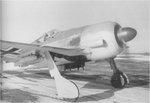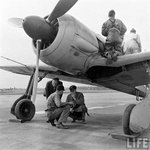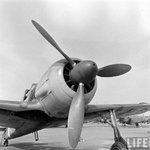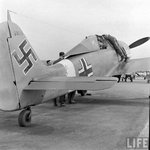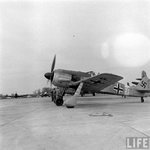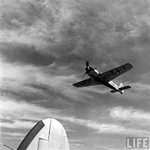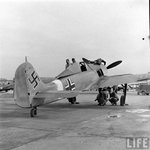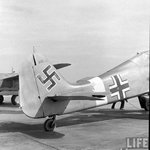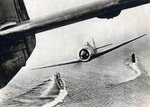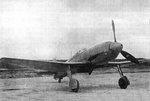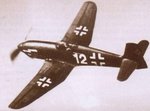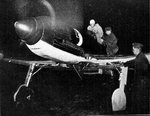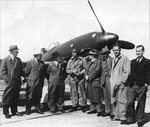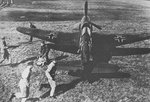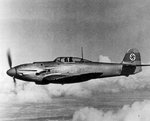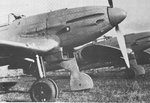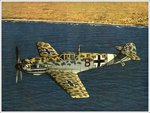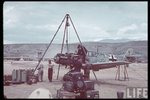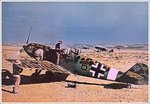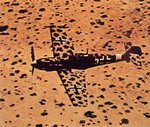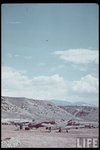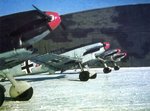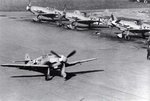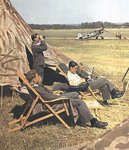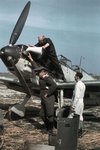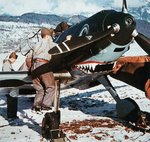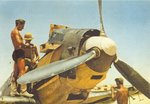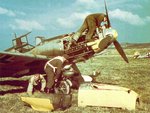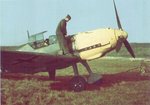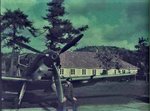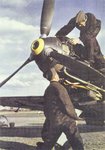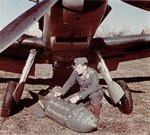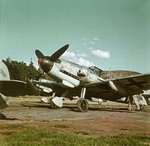- Thread starter
- #41
In autumn 1937, the German Ministry of Aviation asked various designers for a new fighter to fight alongside the Messerschmitt Bf 109, Germany's front line fighter. Although the Bf 109 was an extremely competitive fighter, the Ministry of Aviation was worried that future foreign designs might outclass it, and wanted to have new aircraft under development to meet these possible challenges. Kurt Tank responded with a number of designs, most incorporating liquid-cooled inline engines. However, it was not until a design was presented using the air-cooled, 14-cylinder BMW 139 radial engine that the Ministry of Aviation's interest was aroused. As this design used a radial engine, it would not compete with the inline-powered Bf 109 for engines, when there were already too few DB 601's to go around. This was not the case for competing advanced designs like the Heinkel He 100 or Focke-Wulf Fw 187, where production would compete with the 109 or Messerschmitt Bf 110 for engine supplies. After the war, Tank denied a rumour that he had to "fight a battle" with the Ministry to convince them of the radial engine's merits.
At the time, the use of radial engines in land-based fighters was relatively rare in Europe, as it was believed that their large frontal area would cause too much drag on something as small as a fighter. Tank was not convinced of this, having witnessed the successful use of radial engines by the US Navy, and felt a properly streamlined installation would eliminate this problem. The hottest point on any air-cooled engine are the cylinder heads, located along the outside diameter of a radial engine. In order to provide sufficient air to cool the engine, the cowling needed to allow airflow at this outer edge, which generally resulted in the majority of the front face of the engine being left open to the air. During the late 1920s, NACA led development of a dramatic improvement by placing an airfoil-shaped ring around the outside of the cylinder heads. The shaping accelerated the air as it entered the front of the cowl, increasing the total airflow, and allowing the opening in front of the engine to be made smaller. Tank introduced a further refinement to this basic concept. He suggested placing most of the airflow components on the propeller itself, in the form of a oversized propeller spinner whose outside diameter was the same as the engine itself. The cowl around the engine proper was greatly simplified, essentially a basic cylinder. Air entered through a small hole at the center of the propeller, and was directed through ductwork in the spinner so it was blowing rearward along the cylinder heads. To provide enough airflow, a cone was placed in the center of the hole, over the propeller hub, which was intended to compress the airflow and allow a smaller hole to be used. In theory, the tight-fitting cowling also provided some thrust due to the compression and heating of air as it flowed through the cowling.
As to the rest of the design philosophy, Tank wanted something more than an aircraft built only for speed. Tank outlined the reasoning: The Messerschmitt 109 [sic] and the British Spitfire, the two fastest fighters in world at the time we began work on the Fw 190, could both be summed up as a very large engine on the front of the smallest possible airframe; in each case armament had been added almost as an afterthought. These designs, both of which admittedly proved successful, could be likened to racehorses: given the right amount of pampering and easy course, they could outrun anything. But the moment the going became tough they were liable to falter. During World War I, I served in the cavalry and in the infantry. I had seen the harsh conditions under which military equipment had to work in wartime. I felt sure that a quite different breed of fighter would also have a place in any future conflict: one that could operate from ill-prepared front-line airfields; one that could be flown and maintained by men who had received only short training; and one that could absorb a reasonable amount of battle damage and still get back. This was the background thinking behind the Focke-Wulf 190; it was not to be a racehorse but a Dienstpferd, a cavalry horse. A main feature of the Fw 190 was its wide landing gear. Tank appreciated that operating from primitive airfields in wartime would require a stable undercarriage — a lesson learned from witnessing the difficulty of moving machinery in the First World War. The wide-track landing gear spacing gave it better ground handling characteristics, and it suffered fewer ground accidents than the Bf 109 with its narrow-track landing gear. The undercarriage was designed to withstand a sink rate of 15 feet per second (4.5 meters per second, 900 feet per minute), double the strength factor usually required. Hydraulic wheel brakes were used.
Most aircraft of the era used cables and pulleys and pulleys to operate their controls. The cables tended to stretch, resulting in 'give' and 'play' that made the controls less crisp and responsive, and requiring constant maintenance to correct. For the new design, the team replaced these with rigid pushrods to eliminate this problem. Another innovation was making the controls as light as possible. The maximum resistance of the ailerons was limited to eight pounds, as the average man's wrist could not exert a greater force. The empennage (tail assembly) featured relatively small horizontal and vertical surfaces. The design team also attempted to minimize changes in the aircraft's trim at varying speeds, thus reducing the pilot's workload. They were so successful in this regard that they found in-flight-adjustable aileron and rudder trim tabs were not necessary. Small, fixed tabs were fitted to control surfaces and adjusted for proper balance during initial test flights. Only the elevator trim needed to be adjusted in flight (a feature common to all aircraft). This was accomplished by tilting the entire horizontal tailplane, which could be adjusted by an electric motor from a -3 to a +5 angle of incidence. Another aspect of the new design was the extensive use of electrically powered equipment instead of the hydraulic systems used by most aircraft manufacturers of the time. On the first two prototypes, the main landing gear was hydraulic. Starting with the third prototype, the undercarriage was operated by push buttons controlling electric motors in the wings, and was kept in position by electric up and down-locks.[12] The armament was also loaded and fired electrically. Tank believed that service use would prove that electrically powered systems were more reliable and more rugged than hydraulics, electric lines being much less prone to damage from enemy fire.
As was the case for the 109, the 190 featured a fairly small wing planform with relatively high wing loading. This presents a trade-off in performance; an aircraft with a smaller wing suffers less drag in most flight and therefore flies faster and may have better range. However, it also means the wing cannot generate extra lift as easily, which is needed for maneuvering or flight at high altitudes.The wings spanned 9.5 m (31 ft 2 in) and had an area of 15 m² (161 ft²). The wing was designed using the NACA 23015.3 airfoil at the root and the NACA 23009 airfoil at the tip.
At the time, the use of radial engines in land-based fighters was relatively rare in Europe, as it was believed that their large frontal area would cause too much drag on something as small as a fighter. Tank was not convinced of this, having witnessed the successful use of radial engines by the US Navy, and felt a properly streamlined installation would eliminate this problem. The hottest point on any air-cooled engine are the cylinder heads, located along the outside diameter of a radial engine. In order to provide sufficient air to cool the engine, the cowling needed to allow airflow at this outer edge, which generally resulted in the majority of the front face of the engine being left open to the air. During the late 1920s, NACA led development of a dramatic improvement by placing an airfoil-shaped ring around the outside of the cylinder heads. The shaping accelerated the air as it entered the front of the cowl, increasing the total airflow, and allowing the opening in front of the engine to be made smaller. Tank introduced a further refinement to this basic concept. He suggested placing most of the airflow components on the propeller itself, in the form of a oversized propeller spinner whose outside diameter was the same as the engine itself. The cowl around the engine proper was greatly simplified, essentially a basic cylinder. Air entered through a small hole at the center of the propeller, and was directed through ductwork in the spinner so it was blowing rearward along the cylinder heads. To provide enough airflow, a cone was placed in the center of the hole, over the propeller hub, which was intended to compress the airflow and allow a smaller hole to be used. In theory, the tight-fitting cowling also provided some thrust due to the compression and heating of air as it flowed through the cowling.
As to the rest of the design philosophy, Tank wanted something more than an aircraft built only for speed. Tank outlined the reasoning: The Messerschmitt 109 [sic] and the British Spitfire, the two fastest fighters in world at the time we began work on the Fw 190, could both be summed up as a very large engine on the front of the smallest possible airframe; in each case armament had been added almost as an afterthought. These designs, both of which admittedly proved successful, could be likened to racehorses: given the right amount of pampering and easy course, they could outrun anything. But the moment the going became tough they were liable to falter. During World War I, I served in the cavalry and in the infantry. I had seen the harsh conditions under which military equipment had to work in wartime. I felt sure that a quite different breed of fighter would also have a place in any future conflict: one that could operate from ill-prepared front-line airfields; one that could be flown and maintained by men who had received only short training; and one that could absorb a reasonable amount of battle damage and still get back. This was the background thinking behind the Focke-Wulf 190; it was not to be a racehorse but a Dienstpferd, a cavalry horse. A main feature of the Fw 190 was its wide landing gear. Tank appreciated that operating from primitive airfields in wartime would require a stable undercarriage — a lesson learned from witnessing the difficulty of moving machinery in the First World War. The wide-track landing gear spacing gave it better ground handling characteristics, and it suffered fewer ground accidents than the Bf 109 with its narrow-track landing gear. The undercarriage was designed to withstand a sink rate of 15 feet per second (4.5 meters per second, 900 feet per minute), double the strength factor usually required. Hydraulic wheel brakes were used.
Most aircraft of the era used cables and pulleys and pulleys to operate their controls. The cables tended to stretch, resulting in 'give' and 'play' that made the controls less crisp and responsive, and requiring constant maintenance to correct. For the new design, the team replaced these with rigid pushrods to eliminate this problem. Another innovation was making the controls as light as possible. The maximum resistance of the ailerons was limited to eight pounds, as the average man's wrist could not exert a greater force. The empennage (tail assembly) featured relatively small horizontal and vertical surfaces. The design team also attempted to minimize changes in the aircraft's trim at varying speeds, thus reducing the pilot's workload. They were so successful in this regard that they found in-flight-adjustable aileron and rudder trim tabs were not necessary. Small, fixed tabs were fitted to control surfaces and adjusted for proper balance during initial test flights. Only the elevator trim needed to be adjusted in flight (a feature common to all aircraft). This was accomplished by tilting the entire horizontal tailplane, which could be adjusted by an electric motor from a -3 to a +5 angle of incidence. Another aspect of the new design was the extensive use of electrically powered equipment instead of the hydraulic systems used by most aircraft manufacturers of the time. On the first two prototypes, the main landing gear was hydraulic. Starting with the third prototype, the undercarriage was operated by push buttons controlling electric motors in the wings, and was kept in position by electric up and down-locks.[12] The armament was also loaded and fired electrically. Tank believed that service use would prove that electrically powered systems were more reliable and more rugged than hydraulics, electric lines being much less prone to damage from enemy fire.
As was the case for the 109, the 190 featured a fairly small wing planform with relatively high wing loading. This presents a trade-off in performance; an aircraft with a smaller wing suffers less drag in most flight and therefore flies faster and may have better range. However, it also means the wing cannot generate extra lift as easily, which is needed for maneuvering or flight at high altitudes.The wings spanned 9.5 m (31 ft 2 in) and had an area of 15 m² (161 ft²). The wing was designed using the NACA 23015.3 airfoil at the root and the NACA 23009 airfoil at the tip.
Attachments
-
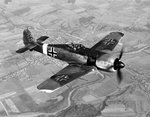 Focke Wulf Fw-190 001.jpg138.3 KB · Views: 253
Focke Wulf Fw-190 001.jpg138.3 KB · Views: 253 -
 Focke Wulf Fw-190 002.jpg50.2 KB · Views: 269
Focke Wulf Fw-190 002.jpg50.2 KB · Views: 269 -
 Focke Wulf Fw-190 003.jpg94.7 KB · Views: 251
Focke Wulf Fw-190 003.jpg94.7 KB · Views: 251 -
 Focke Wulf Fw-190 004.jpg81.6 KB · Views: 249
Focke Wulf Fw-190 004.jpg81.6 KB · Views: 249 -
 Focke Wulf Fw-190 005.jpg72.5 KB · Views: 254
Focke Wulf Fw-190 005.jpg72.5 KB · Views: 254 -
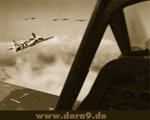 Focke Wulf Fw-190 006.jpg120.3 KB · Views: 254
Focke Wulf Fw-190 006.jpg120.3 KB · Views: 254 -
 Focke Wulf Fw-190 007.jpg67.8 KB · Views: 253
Focke Wulf Fw-190 007.jpg67.8 KB · Views: 253 -
 Focke Wulf Fw-190 008.jpg74.1 KB · Views: 260
Focke Wulf Fw-190 008.jpg74.1 KB · Views: 260

